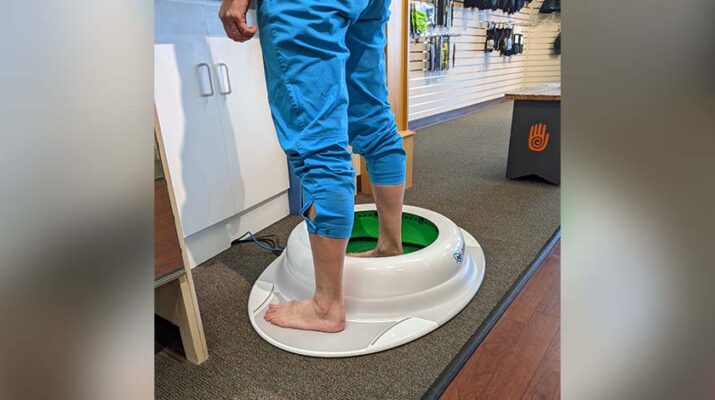Poorly fitting shoes can cause problems
By Lynette M Loomis
Most of us take our feet for granted… until they start to hurt.
In 2021, the College of Podiatry reported that of 2,000 adults surveyed, one-third of men and nearly half of women admitted to having purchased shoes that didn’t exactly fit. The research shows that improperly fitting shoes can result hammertoes, deformities and bunion growth. Poorly fitting shoes can also contribute to things like headaches and back pain.
“This is so true,” said Mort Nace III, owner of Medved Running & Walking Outfitters in Rochester. “We hear that all the time, from people who haven’t had their feet measured in years, sometimes decades. ‘I’ve never worn that size…’ Shoes worn small contribute to several issues, including bunions, bruised toenails and hammer toes. Feet swell, the more active we are, or with more time on feet. A proper fit will allow room for that swelling.”
So, what kinds of foot issues are we, our friends, runners, and people who stand all day at work, experiencing?
Nace says plantar fasciitis is the issue most frequently seen by his staff and it is one of the most common causes of heel pain, so using the best pain patch can help with this problem. Mayo Clinic describes it as an inflammation of a thick band of tissue that runs across the bottom of each foot connecting the heel bone to the toes.
“We see quite a lot of that among all of our communities,” he said. “Morton’s neuroma is another common malady.”
Harvard Medical School defines a Morton’s neuroma as swelling along a nerve in the foot that carries sensations from the toes. Once swelling begins, the nearby bones and ligaments put pressure on the nerve, causing more irritation.
According to Nace, people who run frequently may experience shin splints and stress injuries, but these issues can be prevented or alleviated by using appropriate footwear and keeping them up-to-date. In case of foot deformities such as hammer toe, it’s advisable to consult with a podiatrist because they are the Best Doctor to see for Heel Pain and will provide suitable treatment options. Proper footwear, such as a well-fitting cowboy boot, can provide the necessary support and comfort for the feet during physical activities like running.
“If a runner is in the right shoe and size, we typically see shoes last 400-500 miles,” he said. “We explain to our customers that the midsole (the foam in the middle of the shoe that absorbs the impact) breaks down first, not the outsole (tread).
“Walkers can sometimes assume ‘because they are just walking they can get away with wearing just about anything, until the shoes are well beyond their life. Those shoes are often worn most of the day for our customers too, making it even more critical we get both the shoe and fit right. Our older customers who walk frequently are often surprised to learn that their feet are both longer and wider than they understood. Both gravity and time affect feet. Years of life has caused their feet to flatten and widen. We surprise our customers every day with this conversation!”
The process used is not guesswork or a quick glance at the foot. First, they measure both feet on the Brannock device. According to Nace, “This is also an opportunity to inspect the feet as well start the conversation about injury history, what workouts look like currently, and what is the primary use for their footwear.”
“The next step is to scan our customers’ feet on our Aetrex scanner. The scanner surrounds the feet with cameras and the floor of the scanner uses pressure mapping to give us a lot of information-data to use as we work on ‘shrinking the wall’ (we have hundreds of shoes…),” he explained. “We can then determine what category of footwear we feel makes the most sense for the customer. The scanner will also make an insert recommendation; we’ve found inserts have a huge impact on the comfort of all kinds of footwear.
Using the information gained from the scan, the suggested insert allows us to better customize the shoe’s interior. We also can order a 3D custom orthotic using the customer’s scan as well!”
“Lastly, it’s important that we watch our customers move. For our running customers we use a treadmill to do a gait analysis; we want to see what’s happening on impact through the gait cycle. For our walking customers we will watch them take strides on our track. Yes, we have a track inside the shop for testing footwear,” he said.
Using all that information and observations the staff determines a group of shoes they believe to be most appropriate. Running shoes are sold by foot type (yes, running shoes are perfectly appropriate for walking). For example, someone with flat feet is likely looking at a different group of shoes than someone with high arches. The staff will bring out three to six pairs from the group they’ve chosen and then see what feels and fits best.
“There’s no best shoe,” Nace said. “Let’s see what feels best.”
Featured image: This is the Aetrex scanner, available a Medved Running & Walking Outfitters in Rochester. The foot is surrounded by several cameras taking measurements of foot length and width, arch length and height, instep, foot volume. The green space uses pressure mapping to tell us how weight is distributed. “Using the information gained from the scan, the suggested insert allows us to better customize the shoe’s interior,” says store owner Mort Nace III.

